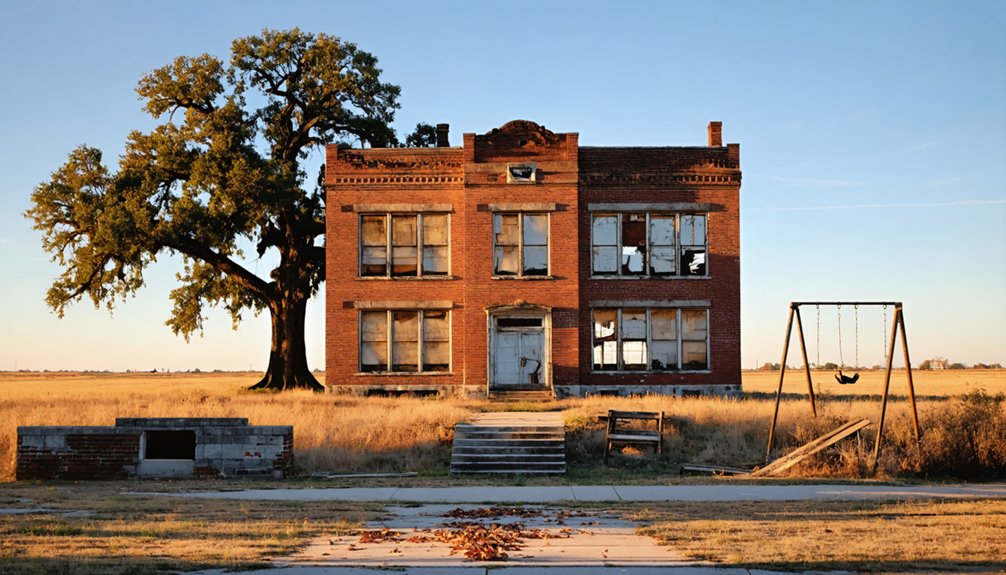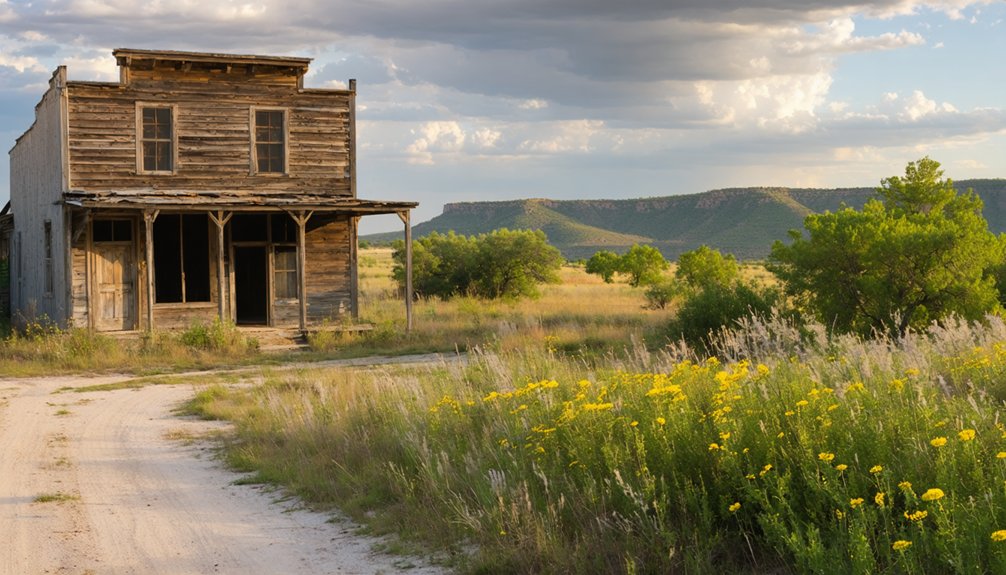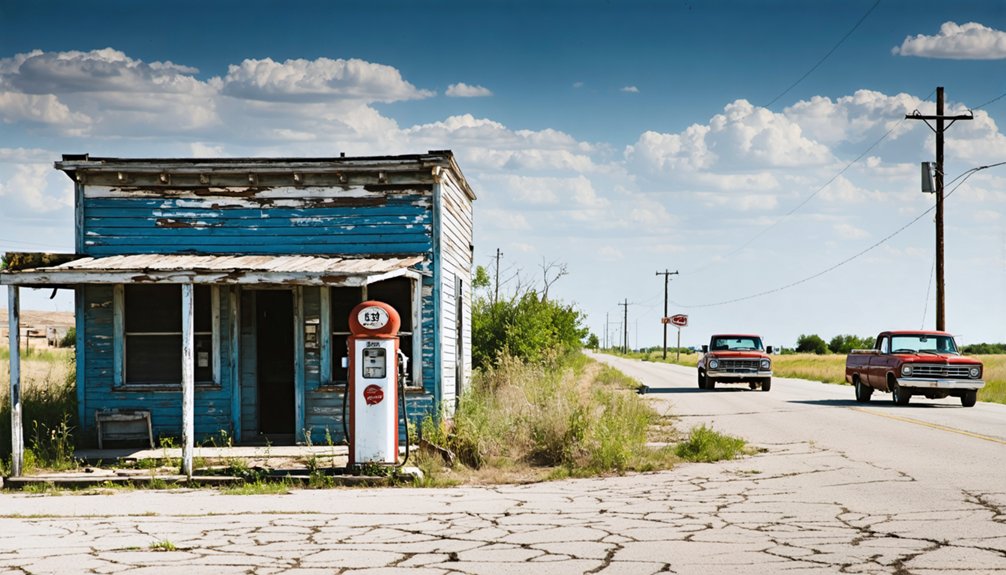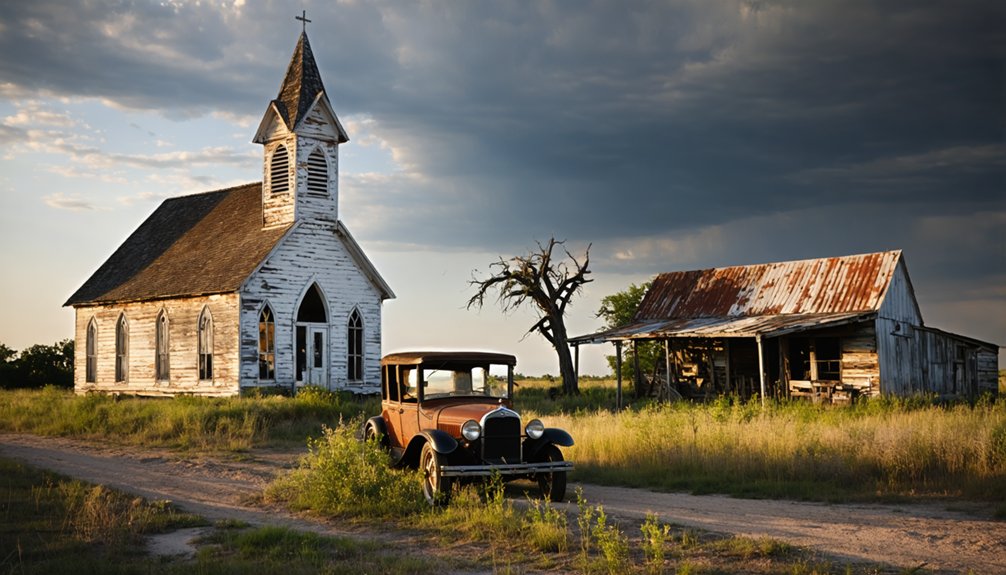You’ll find Izoro tucked away in Lampasas County’s rolling hills, a ghost town that began as “Higgins Gap” in 1857. The settlement thrived with its post office establishment in 1886, when it was renamed “Izoro.” Early challenges included settler feuds and Indian raids, while the community centered on farming and ranching. Today, this abandoned town’s decaying structures and rich history paint a fascinating picture of rural Texas’ transformation. The stories behind each weathered building hold centuries of frontier tales.
Key Takeaways
- Izoro’s population declined to just 17 residents by 2000, transforming from a thriving 19th-century settlement into a near-abandoned ghost town.
- The community originated in 1857 as Higgins Gap before being renamed Izoro in 1886 when establishing its post office.
- Economic challenges, including cotton farming decline and the Great Depression, led to significant population loss throughout the 20th century.
- Located in Lampasas County’s rolling hills, Izoro now features abandoned buildings and structures in various states of decay.
- The town’s decline accelerated when the railroad bypassed it and residents migrated to nearby urban centers like Killeen-Temple-Fort Hood.
The Birth of Higgins Gap
While many Texas ghost towns emerged from mining or oil booms, Higgins Gap began as a frontier ranching settlement in 1857 when the Higgins family, led by John Calhoun Pinckney Higgins, established their homestead in what’s now Lampasas County.
You’ll find the roots of this community deeply embedded in Texas frontier expansion, where the Higgins family carved out their legacy in the untamed wilderness. Known as “The Reluctant Rifleman,” John Higgins helped shape the area’s ranching lifestyle during a time when open-range cattle drives dominated the local economy. Similar to the later development of Higgins, Texas in 1887, which was established by prominent cattleman G.H. Higgins, the settlement’s ranching heritage played a vital role in its identity.
The settlement’s strategic location in a natural pass through the hills made it ideal for moving livestock, while scattered homesteads and ranches dotted the rugged landscape. Life wasn’t easy – lawlessness and feuds marked these early days of settlement. The area became particularly notorious during the Horrell-Higgins feud of 1877, which required Texas Rangers intervention to restore peace.
Name Change and Post Office Establishment
As the settlement grew beyond its frontier roots in 1886, Higgins Gap faced a critical turning point when residents petitioned for a post office. The name change significance emerged when the U.S. Post Office rejected “Higgins Gap,” prompting the adoption of “Izoro” – a unique name that would distinguish the settlement from other Texas towns.
The postal service impact transformed the community’s development. You’ll find that this new designation served as more than just a mail hub; it became the heart of the settlement’s identity and growth. Like Independence Baptist Church in Independence, Texas, which served as a central landmark for its community, the post office became a defining feature of Izoro.
The post office facilitated essential connections to the outside world, enabling trade, communication, and the flow of news. This administrative milestone marked Izoro’s evolution from a rugged frontier outpost into a structured community, though the origin of its distinctive new name remains a historical mystery. Today, the old gas station still serves as the post office, maintaining this important historical connection.
Early Settler Conflicts and Indian Raids
During Izoro’s early days as Higgins Gap, you’ll find a community challenged by both internal settler feuds over property and external threats from Indian raids on isolated homesteads.
The settlers established informal defense groups and relied heavily on firearms, while maintaining vigilant watch over travel routes and gathering points throughout the area. The practice of using armed guards to control access was also common in other Texas towns like Thurber.
These ongoing conflicts had lasting effects on the settlement’s growth, contributing to its sparse population and eventual decline into a ghost town status by the late 20th century. Like many similar communities across Texas, the town’s struggles mirror the pattern of boom and bust that defined numerous settlements throughout the state.
Settler Feuds and Violence
Small towns across west Texas fought fiercely for political and economic dominance in the frontier era, with Izoro’s early history marked by intense settler rivalries and resource disputes.
You’ll find that control over land, water rights, and grazing areas often sparked bitter feuds between early settlers, sometimes erupting into violent confrontations that shaped the community’s development.
Like many frontier settlements, Izoro’s residents struggled to establish order amid the chaos of competing interests and limited resources. Similar to how county seat theft devastated Plemons, these disputes could permanently alter a town’s future.
The situation became so heated that Texas Rangers intervened to maintain peace during heated disputes between rival settlements.
Land disputes frequently pitted neighbor against neighbor as families vied for control over valuable territories.
The area’s volatile mix of lawlessness and settler rivalries created an unstable environment where survival often depended on a family’s ability to protect their claims and forge alliances within the community.
Native American Defense Battles
While settlers established their presence in the Izoro region, fierce conflicts erupted between Native American tribes and newcomers throughout the 1840s-1870s. Military campaigns that began in 1874 aimed to forcibly relocate tribes to reservations in Indian Territory.
The Southern Plains Indians launched devastating raids into settlements, capturing thousands of people and disrupting expansion efforts. You’ll find that cultural resilience drove tribes like the Comanche and Kiowa to defend their ancestral lands against encroachment. The historical narratives reveal how spiritual leaders like Isa-tai united warriors for large-scale resistance, while diminishing buffalo herds and inadequate government rations intensified the tensions.
In the surrounding Texas territory, significant battles like the Council House Fight and Adobe Walls demonstrated the tribes’ determination to protect their way of life.
The Red River War marked a turning point as U.S. forces sought to confine natives to reservations, culminating in devastating losses at Palo Duro Canyon that forever changed the region’s cultural landscape.
Life in 19th Century Izoro
Life in nineteenth-century Izoro reflected the rugged determination of Texas frontier settlers. You’d have found yourself in a close-knit farming community where daily routines revolved around working the land and tending to livestock.
Originally known as Higgins Gap, the town’s establishment of a post office in 1886 marked its growth into a proper settlement.
Your home would’ve been a simple wooden or log structure, warmed by wood stoves and supplied by well water. Community events centered around church gatherings, where you’d share stories and celebrate with neighbors.
You’d rely on horses and wagons for transportation, with challenging journeys to nearby towns. Despite the isolation, you’d find strength in the mutual support of fellow settlers, sharing labor and resources to overcome the frontier’s hardships.
Educational Legacy and School History

The quest for education shaped Izoro’s community spirit beyond its farming roots. While specific records of Izoro’s school have been lost to time, you’ll find its educational story mirrors other frontier Texas communities of the early 1900s.
Like many rural towns, Izoro’s school community likely gathered in a modest wooden structure that doubled as a meeting place, where students of various ages learned together in one or two rooms.
You can trace the school’s challenges through the region’s economic shifts. As cotton farming declined and the Great Depression hit, families moved away seeking work, leading to dwindling enrollment.
Though the physical school building no longer stands, its legacy lives on through oral histories and the lasting impact of rural education on frontier literacy and social mobility.
Population Changes Through the Years
Anyone searching for Izoro’s population story will find a classic tale of rural Texas transformation. While early 20th-century records don’t show exact numbers, you’ll find evidence of population stability through the presence of a local school by 1914 and an active farming community.
The mid-1900s brought significant changes as rural migration took its toll. You’ll see familiar patterns that affected many Texas towns – mechanized farming reduced labor needs, while nearby urban centers like Killeen-Temple-Fort Hood drew residents away with better opportunities.
By 2000, you’d find only 17 people calling Izoro home, marking its near-ghost town status.
With just 17 residents at the millennium’s turn, Izoro stands as a testament to Texas’s fading rural communities.
Today, while the community remains unincorporated, it persists with a small but steady population, served by the Lampasas Independent School District.
Geographic Features and Natural Setting

Situated within Lampasas County’s rolling hills, Izoro occupies a distinctive slice of Texas Hill Country terrain about 18 miles northeast of the county seat.
You’ll find the community at coordinates 31.29444°N, 98.07556°W, where limestone and caliche soils support a rich tapestry of natural resources.
The area’s ecological diversity shines through its oak-juniper woodlands and native prairie grasses.
You’re just five miles from the life-giving Lampasas River, while natural springs dot the landscape.
The humid subtropical climate brings hot summers and mild winters, with annual rainfall between 25-35 inches supporting local wildlife and vegetation.
The terrain’s gentle slopes and grasslands once served the community’s agricultural needs, while today they preserve the untamed character of Central Texas’s natural heritage.
Surviving Structures and Remnants
Today you’ll find Izoro’s surviving structures in various states of decay, from crumbling adobe walls to partially intact foundations that hint at the town’s mining heritage.
The remaining buildings showcase typical early 20th-century construction materials including local stone, adobe bricks, and wooden framework, though many structures have lost their roofs to time.
You can spot evidence of more recent preservation attempts on select buildings, where caretakers have reinforced original materials while maintaining historical authenticity.
Historic Buildings Today
While many Texas ghost towns have completely vanished, Izoro retains scattered remnants of its mining past through various structural ruins and equipment.
You’ll find foundation fragments, partial walls, and deteriorating adobe homes dotting the landscape, offering glimpses into early 20th-century mining life. During ghost town exploration, you’ll notice old mining equipment near windmills and several relatively intact buildings from later construction periods.
Natural springs support patches of trees growing alongside the architectural decay, creating an unusual contrast in this arid setting.
Unlike some restored ghost towns such as Lobo, Izoro remains largely untouched, though fencing and no-trespassing signs protect unstable structures.
The site’s rock-based constructions have generally outlasted their adobe counterparts, but most buildings have succumbed to time and erosion.
Building Material Analysis
The diverse building materials of Izoro’s surviving structures tell a fascinating story of early 20th-century construction methods.
You’ll find predominant adobe brick construction throughout the town, chosen for its excellent insulating properties in West Texas’s arid climate. A material durability analysis reveals that wood-framed buildings have weathered time better than their adobe counterparts, though they’re fewer in number.
Through structural analysis, you can trace the town’s industrial heritage in the metal and heavy timber remnants of mining equipment near the settlement.
While most buildings have crumbled into rubble, you’ll notice foundations of stone and compacted earth still marking original building locations. Some structures incorporated locally sourced rock, which has proven more resilient than adobe, though it wasn’t as commonly used in construction.
Modern Day Community Profile

As a proof of its ghost town status, modern-day Izoro stands largely abandoned with minimal to no permanent residents occupying its remaining structures.
You’ll find no active businesses, functioning utilities, or maintained public infrastructure in this once-vibrant Texas community. The town’s properties have seen sharp declines in value, with most buildings falling into disrepair or reverting to nature.
While ghost town tourism occasionally brings visitors interested in historical preservation, there’s no sustained community life. You won’t find traditional services, active governance, or social institutions.
The surrounding landscape has returned to its natural state, with unmanaged terrain and wild vegetation dominating the area. The town serves primarily as a historical reference point, studied and remembered through regional museums and historical societies in Lampasas County.
Historical Significance in Lampasas County
You’ll find Izoro’s historical significance deeply rooted in the Texas Hill Country’s early settlement patterns, where its strategic location near the Lampasas River made it attractive to pioneering farmers.
The community’s development faced typical challenges of frontier settlements, including the need to establish sustainable agriculture amid the region’s variable climate and terrain.
Like many small Texas towns of its era, Izoro’s economic growth centered on agricultural processing, with its mills and cotton gin serving as essential infrastructure for local farmers until changing economic conditions led to its eventual decline.
Early Settlement Origins
Originally known as Higgins Gap, Izoro emerged along a significant stagecoach trail connecting Pearl to Townsen Mills in Lampasas County during the late 19th century.
The settlement patterns followed the region’s natural resources, with early pioneers like the Higgins family establishing roots in this part of the Edwards Plateau. You’ll find the community’s origins deeply tied to the agricultural practices that dominated Lampasas County’s economy, including cattle ranching and farming.
The area’s strategic location along transportation routes proved essential for its development, leading to the establishment of a post office in 1886.
Like many communities in Lampasas County, Izoro’s settlers benefited from the region’s limestone-rich terrain and access to water sources, though they’d later face challenges from the devastating boll weevil infestation of the 1930s.
Native American Conflicts
During the mid-nineteenth century, Native American conflicts profoundly shaped Izoro’s early development, mirroring the broader struggles throughout Lampasas County.
You’ll find that Comanche warriors fiercely defended their ancestral hunting grounds, conducting raids that tested settler communities’ cultural resilience. The violence peaked in the 1860s, when notable incidents like the 1862 raid left James Gracey dead and about hundred horses stolen.
The historical narrative of Izoro reflects the broader Texas-Indian wars, where militia engagements became commonplace.
The Carter family’s losses exemplify the personal toll these conflicts took, with two officers killed in separate incidents.
Despite the challenges, settlers persisted in building their community, though raids and reduced military protection after the Civil War considerably slowed Izoro’s growth and economic development.
Economic Growth Challenges
While Izoro’s strategic position along an old stagecoach trail between Pearl and Townsen Mills initially promised economic potential, the town faced significant growth challenges that would ultimately contribute to its decline.
The town’s lack of economic diversification left it vulnerable to devastating agricultural setbacks, particularly during the 1930s boll weevil infestation that decimated cotton crops.
You’ll find that Izoro’s agricultural resilience was severely tested as it struggled to adapt to changing economic conditions.
- Competition from Lampasas’ mineral springs tourism and commercial development drew investment away from Izoro.
- The shift from stagecoach to railroad transportation bypassed the town, limiting trade opportunities.
- Post-Civil War instability, including increased outlaw activity and Indian raids, discouraged new settlement and economic growth.
Frequently Asked Questions
What Major Roads or Highways Currently Connect Izoro to Neighboring Towns?
You’ll find limited highway access to neighboring towns, with Farm Road 1690 serving as your main connection to Lampasas, while smaller county roads branch off for local travel.
Were There Any Notable Churches or Religious Communities Established in Izoro?
Though a million stories shape Texas ghost towns’ church history, you won’t find documented religious architecture or established churches in Izoro. Local worship likely occurred informally or in neighboring communities.
What Traditional Festivals or Community Gatherings Were Celebrated in Izoro?
You’d find traditional celebrations centered on harvest festivals, barn dances, and religious gatherings. Community events included school plays, livestock shows, market days, and cooperative work gatherings like barn-raisings.
Did Any Famous or Noteworthy Historical Figures Ever Visit Izoro?
You won’t find any famous visitors in Izoro’s past. Historical records show no documented visits by notable figures, as the town’s historical significance remained centered around its local pioneer families.
What Indigenous Tribes Originally Inhabited the Area Before Izoro’s Settlement?
You’ll find rich cultural heritage in the area’s tribal history, where Comanche were dominant, while Tonkawa, Apache, and Kiowa tribes also inhabited or traversed these ancestral hunting grounds.
References
- https://www.county.org/county-magazine-articles/summer-2025/ghost-towns
- https://www.texasescapes.com/ClayCoppedge/Izoro.htm
- https://www.youtube.com/watch?v=phjUE19A8HM
- https://texashighways.com/travel-news/four-texas-ghost-towns/
- https://www.texasescapes.com/TexasHillCountryTowns/Izoro-Texas.htm
- https://en.wikipedia.org/wiki/List_of_ghost_towns_in_Texas
- https://en.wikipedia.org/wiki/Izoro
- https://www.tshaonline.org/handbook/entries/izoro-tx
- https://amarillodepot.com/higgins-texas/
- https://truewestmagazine.com/article/bold-and-lethal/



